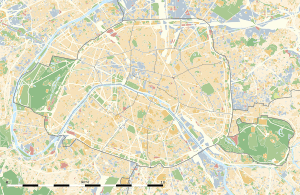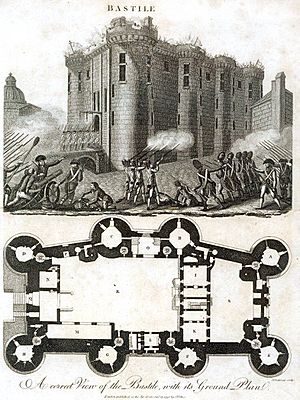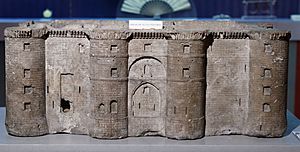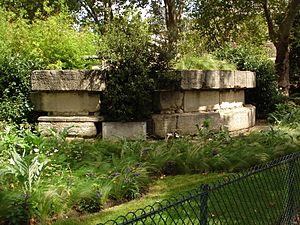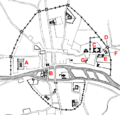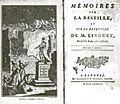Bastille facts for kids
Quick facts for kids Bastille |
|
|---|---|
| Paris, France | |
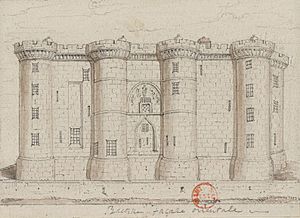
East view of the Bastille, drawing c. 1790
|
|
| Coordinates | 48°51′12″N 2°22′09″E / 48.85333°N 2.36917°E |
| Type | Medieval fortress, prison |
| Site information | |
| Condition | Destroyed, limited stonework survives |
| Site history | |
| Built | 1370–1380s |
| Built by | Charles V of France |
| Demolished | 1789–90 |
| Events | Hundred Years' War Wars of Religion Fronde French Revolution |
The Bastille was a famous prison in Paris, France. It was a very strong building. People attacked it during the French Revolution on 14 July 1789. This attack is seen as the start of the French Revolution. Today, July 14th is a national holiday in France. It is called Fête Nationale or Bastille Day.
Contents
History of the Bastille Fortress
The Bastille was built during the Hundred Years' War. It was first called the Bastion de Saint-Antoine. It started as a simple gate. Between 1370 and 1383, it became a large fortress. It protected the eastern part of Paris. It also guarded the royal palace called Hôtel Saint-Pol. After the war, it was used as a prison. King Louis XIII was the first king to send prisoners there.
How the Bastille was Built
The Bastille was shaped like a rectangle. It was about 70 meters (220 feet) long. It was also 30 meters (90 feet) wide. It had eight tall towers. The walls were 25 meters (80 feet) high. A wide moat (a deep ditch) surrounded the outside. Inside, there were two courtyards. Houses were built against the walls.
Two towers on the east and west had gates. A street called rue Saint-Antoine passed through them. Later, these gates were blocked. A new city gate was built to the north. A strong bastion (a part of the wall sticking out) was added on the eastern side. The walls and towers were all the same height. A wide path connected them. This allowed soldiers to move quickly. It also made room for artillery (large guns). A similar design can be seen at Château de Tarascon.
The Storming of the Bastille

As a prison, the Bastille held many different people. It held common criminals like forgers and thieves. It also held people jailed for their religion, such as the Huguenots. Some prisoners had written things against the government or the King. Important people were sometimes held there too.
The prison could hold about 50 prisoners. It was not the worst prison in Paris. But it was very secret. This made people think it was a terrible place.
Why the Bastille was Attacked
The people of Paris attacked the Bastille on July 14, 1789. This happened after many days of protests. They wanted the gunpowder and weapons stored there. They were not attacking to free the seven prisoners inside.
The prison was guarded by about 80 old soldiers called invalides. Their leader was Governor Bernard-René de Launay. There was also a group of 32 grenadiers. These were mercenary soldiers from Switzerland. The King had brought them to Paris just before July 14.
By mid-morning, about 8,000 men and women were outside. They wanted the guards to give up the prison. They also wanted the artillery guns removed. And they wanted the gunpowder and weapons. Two people from the crowd were invited inside. They talked with the Governor.
Around 1:00 PM, the crowd broke into the outer courtyard. The chains on the drawbridge to the inner courtyard were cut. There was some gunfire. By mid-afternoon, the crowd got help. Gardes Françaises (French Guards) from the Royal Army joined them. They also brought two cannons.
Governor de Launay told his guards to stop shooting. He gave up the fortress. The crowd rushed into the Bastille around 5:30 PM.
After the Attack
The crowd took the weapons and gunpowder. They freed the seven prisoners. They had to break down the doors to the cells. The keys had already been taken and shown in the streets. Even though the Governor and some guards had surrendered, they were killed by the crowd.
Pulling Down the Bastille
The importance of the Bastille was quickly understood. A man named Pierre-François Palloy started pulling it down. He was known as "Patriote Palloy." He gathered a group of men to begin the demolition the very next day. People paid him to see the site. He also sold pieces of the fortress as souvenirs. By November 1789, most of the Bastille was gone. The stones from the fortress were used to build the Pont de la Concorde (Paris) bridge.
The Bastille Area Today
The place where the Bastille once stood is now called the Place de la Bastille. The Opéra Bastille (a large opera house) is located there. The big moat behind the old fort is now a marina for boats. It is called the Bassin de l'Arsenal. To the north, a covered canal, the Canal Saint Martin, runs under the road.
Remains of the Bastille
Parts of one tower were found in 1899. This happened during digging for the Métro (Paris's subway system). These stones were moved to a park nearby. It is called the Square Henri-Galli. The shape of the old fort is also marked on the streets. Special paving stones show its outline. A cafe and other businesses are now on the site. The rue Saint Antoine road passes right over it.
The Bastille in Stories
The Bastille appears in many famous stories:
- Comte de Rochefort (in The Three Musketeers and Twenty Years After)
- Alexandre Manette (in A Tale of Two Cities)
- M. Thénardier (in Les Misérables)
- Several stories about the Man with the iron mask
Related pages
Images for kids
-
Parisian defences in 14th century: A – Louvre; B – Palais de Roi; C – Hôtel des Tournelles; D – Porte Saint-Antoine; E – Hôtel St Paul; F – the Bastille
-
A depiction of the Bastille and neighbouring Paris in 1575, showing the new bastions, the new Porte Saint-Antoine, the Arsenal complex and the open countryside beyond the city defences
-
The Bastille in 1647, illustrating the bastion, the stone abutment linking to the fortress and the new southern entrance built during the 1550s
-
Dragons destroy the Bastille on the title page of Bucquoy's Die Bastille oder die Hölle der Lebenden.
See also
 In Spanish: Bastilla para niños
In Spanish: Bastilla para niños


